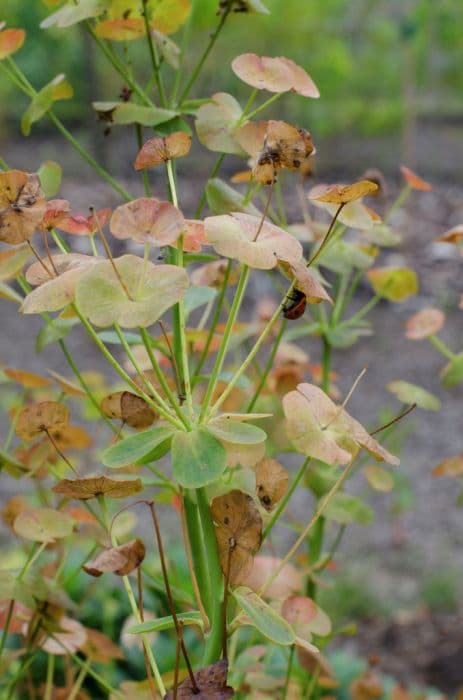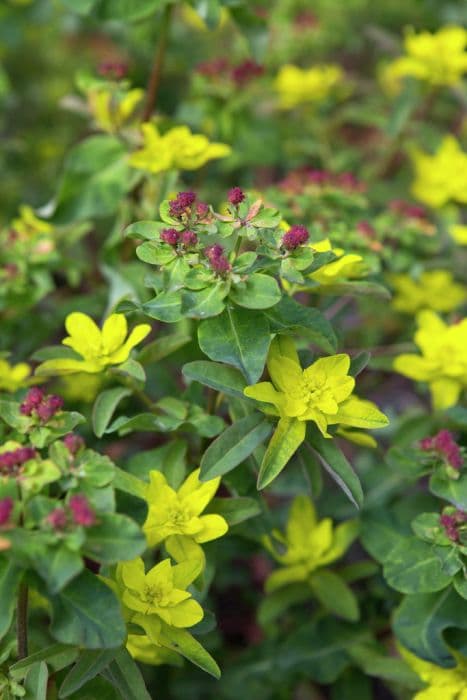Cypress Spurge Euphorbia cyparissias 'Fens Ruby'

ABOUT
Euphorbia cyparissias 'Fens Ruby', also commonly known as Cypress spurge 'Fens Ruby', presents a compelling display of feathery, needle-like foliage that changes color throughout the seasons. The leaves initially emerge with a purple or ruby-red tint in spring, providing a striking contrast to the brighter greens commonly found in gardens at this time of year. As the plant matures through the growing season, the foliage transforms into a soft bluish-green, still keeping some of the reddish highlights. This creates a wispy, almost whimsical appearance, as if it were a delicate cloud of color softening the surrounding garden landscape. Cypress spurge 'Fens Ruby' blooms in the late spring to early summer, with small, inconspicuous flowers. These flowers are surrounded by bracts, which are modified leaves that often appear bright and petal-like. In this variety, bracts take on a yellowish hue, adding another layer of visual interest and complementing the colorful foliage. Overall, the plant exudes a fine-textured, airy appearance, making it a lovely addition to rock gardens, borders, and groundcover settings. Its changing hues and subtle floral display offer gardeners a dynamic and evolving element in their outdoor spaces.
About this plant
 Names
NamesFamily
Euphorbiaceae
Synonyms
Cypress Spurge, Graveyard Moss, Fens Ruby
Common names
Euphorbia cyparissias 'Fens Ruby'
 Toxicity
ToxicityTo humans
Cypress spurge, the common name for Euphorbia cyparissias 'Fens Ruby', contains a toxic milky sap known for causing skin irritation and sometimes blisters upon contact. If ingested, this sap can induce nausea, vomiting, and diarrhea. In severe cases, it may lead to more serious symptoms such as difficulty swallowing, throat swelling, or even systemic reactions in individuals with high sensitivity. It is imperative to avoid ingestion and minimize skin contact with the sap, and if exposure occurs, seek medical attention.
To pets
For pets, cypress spurge is similarly toxic due to its milky sap. If pets come into contact with or ingest the plant, they may experience symptoms such as drooling, vomiting, diarrhea, and difficulty breathing. The skin and mouth may also become irritated, and there is a risk of eye irritation if the sap comes into contact with the pet's eyes. If a pet is suspected of ingesting cypress spurge or having significant contact with its sap, immediate veterinary care is advised.
 Characteristics
CharacteristicsLife cycle
Perennials
Foliage type
Deciduous
Color of leaves
Green
Flower color
Yellow
Height
1 foot (30 cm)
Spread
1 foot (30 cm)
Plant type
Herb
Hardiness zones
4
Native area
Europe
Benefits
 General Benefits
General Benefits- Low Maintenance: Euphorbia cyparissias 'Fens Ruby', commonly known as Cypress Spurge 'Fens Ruby', is a hardy plant that requires minimal care once established.
- Drought Resistance: It has good drought tolerance, making it suitable for xeriscaping or for gardens in dry climates.
- Attractive Foliage: The plant features attractive, needle-like leaves that change from bright green to red or purple, adding color interest to the garden.
- Rapid Growth: Cypress Spurge 'Fens Ruby' grows quickly, providing fast coverage and filling in garden spaces efficiently.
- Erosion Control: Its dense growth habit makes it useful for stabilizing soil and preventing erosion on slopes or banks.
- Adaptability: It can adapt to a wide range of soil types and is not fussy about pH levels.
- Ground Cover: It serves as an excellent ground cover, suppressing weeds and covering large areas with minimal effort.
- Wildlife Attraction: While the sap is toxic to humans and animals, the plant can attract beneficial insects like pollinators to the garden.
- Seasonal Interest: In addition to its foliage, the plant produces small yellow flowers that add visual interest during its blooming period.
- Landscape Versatility: This plant can be used in rock gardens, borders, and as a filler plant, providing versatility in landscape design.
 Medical Properties
Medical Properties- This plant is not used for medical purposes.
 Air-purifying Qualities
Air-purifying QualitiesThis plant is not specifically known for air purifying qualities.
 Other Uses
Other Uses- Cypress Spurge 'Fens Ruby' can be used as a natural dye, providing shades of yellow or green depending on the mordant used.
- It may be included in a wildlife garden to provide a habitat for certain species of moths and butterflies that use it as a food source.
- Gardeners can cultivate Cypress Spurge 'Fens Ruby' for its attractive foliage as a ground cover in rock gardens or alpine collections.
- Some artists may use the latex sap of Cypress Spurge 'Fens Ruby' as a medium in natural painting techniques, though this is rare and must be handled with care due to potential skin irritation.
- The dense mat of Cypress Spurge 'Fens Ruby' can be used to stabilize soil on slopes or banks to prevent erosion.
- Photographers might seek out Cypress Spurge 'Fens Ruby' for its vibrant foliage and interesting texture as a subject for botanical photography.
- Interplanted in a vegetable garden, Cypress Spurge 'Fens Ruby' could potentially distract certain pests away from more valuable crops.
- Its unique texture and color can be used in dried flower arrangements and crafts for a touch of natural, muted tones.
- Cypress Spurge 'Fens Ruby' can act as a "nurse plant" providing shelter for young, delicate plants that need protection from the wind or intense sun.
- Traditional crafts sometimes make use of dried Euphorbia stems, including those of Cypress Spurge 'Fens Ruby,' for basket weaving or ornamental designs.
Interesting Facts
 Feng Shui
Feng ShuiThe Cypress Spurge is not used in Feng Shui practice.
 Zodiac Sign Compitability
Zodiac Sign CompitabilityThe Cypress Spurge is not used in astrology practice.
 Plant Symbolism
Plant Symbolism- Persistence and Resilience: Euphorbia cyparissias, commonly known as Cypress Spurge, is known for its hardy nature and ability to survive in tough conditions, symbolizing the human traits of persistence and resilience.
- Caution and Hazard: The plant is toxic and can cause skin irritation upon contact, which is why it symbolizes caution and the need to be aware of potential dangers.
- Transformation and Renewal: Cypress Spurge has a lifecycle that includes periods of dormancy followed by vigorous growth, representing transformation and the ability to renew oneself.
- Protection: In some cultures, Euphorbia species are thought to have protective qualities, thus Cypress Spurge may symbolize safeguarding oneself or one's home from harm.
 Water
WaterCypress spurge (Euphorbia cyparissias 'Fens Ruby') prefers to be kept on the drier side, so it is important to water it sparingly. The soil should be allowed to dry out completely between waterings. You can water this plant approximately once every two weeks during the active growing season, reducing frequency in the winter months. When you do water, make sure to soak the soil thoroughly, which might typically involve about 1-2 gallons depending on the size of the plant and the pot. Overwatering can lead to root rot, so ensure proper drainage.
 Light
LightCypress spurge thrives in full sun to partial shade. For optimal growth, place it in a location where it receives at least 6 hours of direct sunlight daily. An east or west-facing location with bright, indirect sunlight for the remainder of the day is ideal. Avoid deep shade, as too little light can lead to leggy growth and a decrease in the vibrancy of its foliage.
 Temperature
TemperatureCypress spurge is quite hardy and can withstand temperatures as low as 0°F and as high as 90°F. However, the ideal temperature range for this plant is between 60°F and 75°F. It's best to avoid extreme fluctuations in temperature to keep the plant healthy and stress-free.
 Pruning
PruningPrune Cypress spurge in late winter or early spring to remove any dead or damaged stems and refresh the plant's appearance. This encourages healthy new growth and maintains the plant's shape. Pruning is typically required annually, and doing so right before the new growth starts gives the plant a clean start for the season.
 Cleaning
CleaningNot needed
 Soil
SoilCypress spurge 'Fens Ruby' requires well-draining soil with a mix of garden loam, peat, or compost, and sharp sand. The ideal pH for this plant is neutral to slightly alkaline, around 7.0 to 7.5.
 Repotting
RepottingCypress spurge 'Fens Ruby' is typically not repotted often as it is a fast-growing, spreading perennial that is usually maintained within its space in the garden rather than grown in containers.
 Humidity & Misting
Humidity & MistingCypress spurge 'Fens Ruby' is tolerant of a wide range of humidity levels and does not require specific humidity conditions to thrive.
 Suitable locations
Suitable locationsIndoor
Ensure bright light, well-draining soil, and minimal watering.
Outdoor
Choose a sunny spot, well-draining soil, and protect from extreme cold.
Hardiness zone
4-8 USDA
 Life cycle
Life cycleEuphorbia cyparissias 'Fens Ruby', commonly known as Cypress Spurge 'Fens Ruby', begins its life cycle as seeds which germinate in spring after a period of cold stratification. The seedlings develop a deep taproot and form a rosette of leaves close to the ground. As the plant matures, it produces narrow, needle-like leaves and stems that contain a milky sap and take on a reddish-purple hue. In late spring to early summer, Cypress Spurge 'Fens Ruby' blooms with small, inconspicuous yellow-green flowers that are surrounded by showy bracts, which attract pollinators. Following pollination, seeds develop and are dispersed by wind or human activity, allowing the plant to colonize new areas, including some where it may become invasive. The plant dies back in autumn, leaving behind a root system that will sprout anew the following spring.
 Propogation
PropogationPropogation time
Spring-Early Summer
Euphorbia cyparissias 'Fens Ruby', commonly known as Cypress Spurge, is typically propagated by division, which is the most popular method. Division should be carried out in early spring or fall when the plant is not in active growth. To propagate by division, carefully dig up the plant, ensuring a good amount of roots are attached to each section. The plant can be divided into smaller clumps, each with several shoots and adequate root systems. These clumps are then replanted into their new location or pots at the same depth they were previously growing. It is important to handle the plant with care, as the sap can be an irritant; using gloves is advisable. After planting, water the divisions well to help establish them in their new environment.


![Spurge [Silver Swan]](/_next/image?url=https%3A%2F%2Fplants-admin.emdemapps.com%2Fimages%2Fplants%2F%2Fimages%2F604b573f6c8f6.png&w=640&q=75)






